- Local Time: 09:23 PM
- Weather: 16 ℃ / 61 ℉
The Wait Is Over – The GRAND EGYPTIAN MUSEUM has finally Opened Its Doors! Be among the ones to explore Egypt’s greatest treasures.
The New Kingdom of Egypt (1570–1070 BCE) was the peak of ancient Egypt’s power and culture. It began with Ahmose I’s victory over the Hyksos and thrived under iconic pharaohs like Hatshepsut, Akhenaten, and Ramses II. Egypt expanded into Nubia and the Levant, gaining wealth through war, trade, and diplomacy. This era saw religious shifts, monumental architecture, and flourishing arts, science, and literature. Despite its glory, the kingdom eventually declined due to internal conflict and foreign invasions, leading to its fall and the rise of foreign rule.

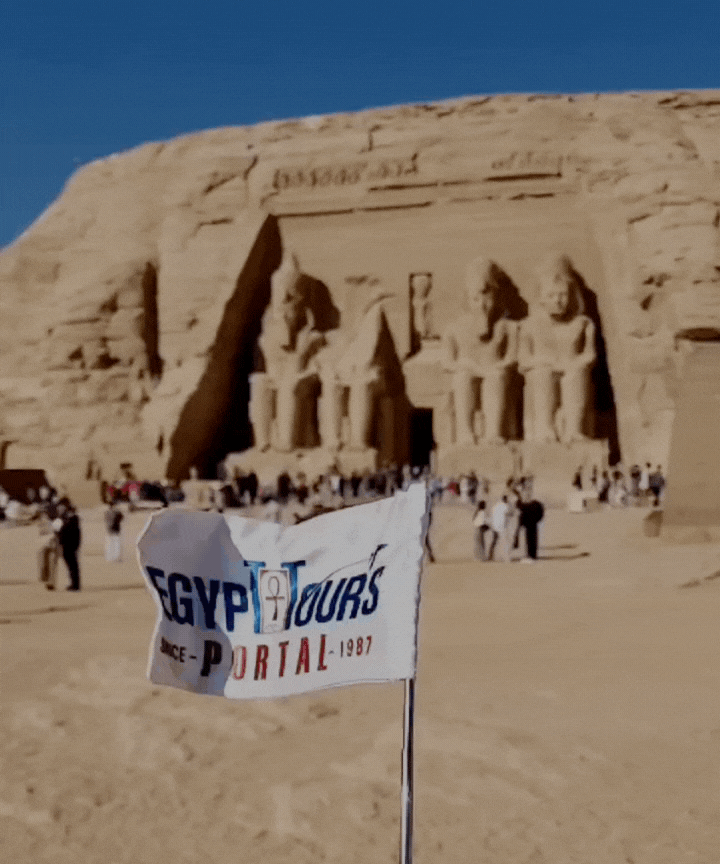
The New Kingdom of Ancient Egypt (1570–1070 BCE) is often regarded as the apex of ancient Egyptian civilization, a period that epitomized the wealth, power, and cultural achievements of ancient Egypt. This golden Egyptian age witnessed the transformation of Egypt into an imperial power, expanding its borders through military conquest and solidifying its role as a dominant force in the ancient world.
The New Kingdom, for five hundred years, was a time of monumental achievements in architecture, art, religion, and statecraft, alongside the reigns of some of Egypt's most iconic pharaohs like Hatshepsut, Thutmose III, and Ramses II, who in turn created some of the most masterpieces of wonder.

The new kingdom Egypt a.k.a the Egyptian Empire (1570–1070 B.C.E) is without a doubt the most popular time period in the history of ancient Egypt that spans from the 16th century to the 11th century B.C most of the ruler's entire history and tombs have been located such as Hatshepsut, Thuthmoses III, Amenhotep III, Akhenaten and his wife Nefertiti, Ahmose I, Tutankhamun and Ramses II.
After the Hyksos took over in the Second Intermediate Period, the Egyptian rulers understood the importance of having strong borders, so during this period, most of the rulers worked on expanding their territory to the fullest and building a true empire protected by a powerful army.
Many battles took place in this era in the hopes of expanding their empire. As this period reached a prime level in wealth and power, there was also a huge religious shift during this time as monotheism and it also saw an end to the central authority.
One of the most pharaohs in The 18th dynasty or possibly in ancient Egyptian in general is Amenhotep IV who changed his to Akhenaten to honor his god Aten and his beautiful wife Nefertiti, he was the first practitioner of monotheism (The Worship of the One God) and under the fourth year of his reign, Egyptian Art like literature, music, drama, and sculpture flourished to an unprecedented level of realism.
After his death came his son Tutankhamen (1333–1324 BC)who was worshiped like a god and died at a very young age of 18, Then comes the time of Ramesses II "The Great" (1279-1213 BC) who worked a retrieving all of Egypt territories in the Levant, one of his most famed battles is the battle of Kadesh against the Hittite in the first recorded military ambush and resulted in the signing of the first recorded peace treaty.
All this information was inscribed on his temple wall in the majestic Abu Simbel temple. He had many wives and a massive number of children, one of whom was Ramesses II, who is most famous for fighting the Sea People in the battle of Djahy.
After the third intermediate period came, thus ending the glory days of the New Kingdom of Egypt, where the high priests of Amun took control, weakening the central authority. All that led to the end of the entire Pharaoh dynasty when the Egyptian Empire fall to the Persian Empire in the battle of Pelusium, thus beginning a new era of foreign rule.
Many future threats from all directions, such as the Hush from the south and the Assyrians from the north and was followed by the rule of many foreign dynasties like the Nubian dynasty in the 25th century BC, the Persian dynasty from the 27th to the 30th century BCE, Alexander the Great, and many more.

The New Kingdom is divided into three distinct dynastic periods: the 18th, 19th, and 20th dynasties, during which Egypt experienced its greatest period of expansion, economic prosperity, and cultural refinement.
It began around 1570 BCE when Ahmose I drove out the Hyksos, foreign rulers who had dominated Lower Egypt during the Second Intermediate Period. This event marked the reunification of Egypt and the dawn of the New Kingdom. Over the next centuries, Egypt expanded its territory, extending its influence from Nubia in the south to the Levant in the north, creating a vast and wealthy empire.
1570 BCE: Ahmose I defeats the Hyksos and reunifies Egypt, initiating the age of the New Kingdom.
1458 BCE: Hatshepsut, the longest-reigning female pharaoh, sends a trade expedition to the land of Punt, securing lucrative trade goods such as myrrh and gold.
1274 BCE: The famous Battle of Kadesh between Ramses II and the Hittites results in a military stalemate but leads to the first recorded peace treaty in history.
1070 BCE: The decline of central authority, weakened by internal strife and external pressures, leads to the beginning of the Third Intermediate Period.
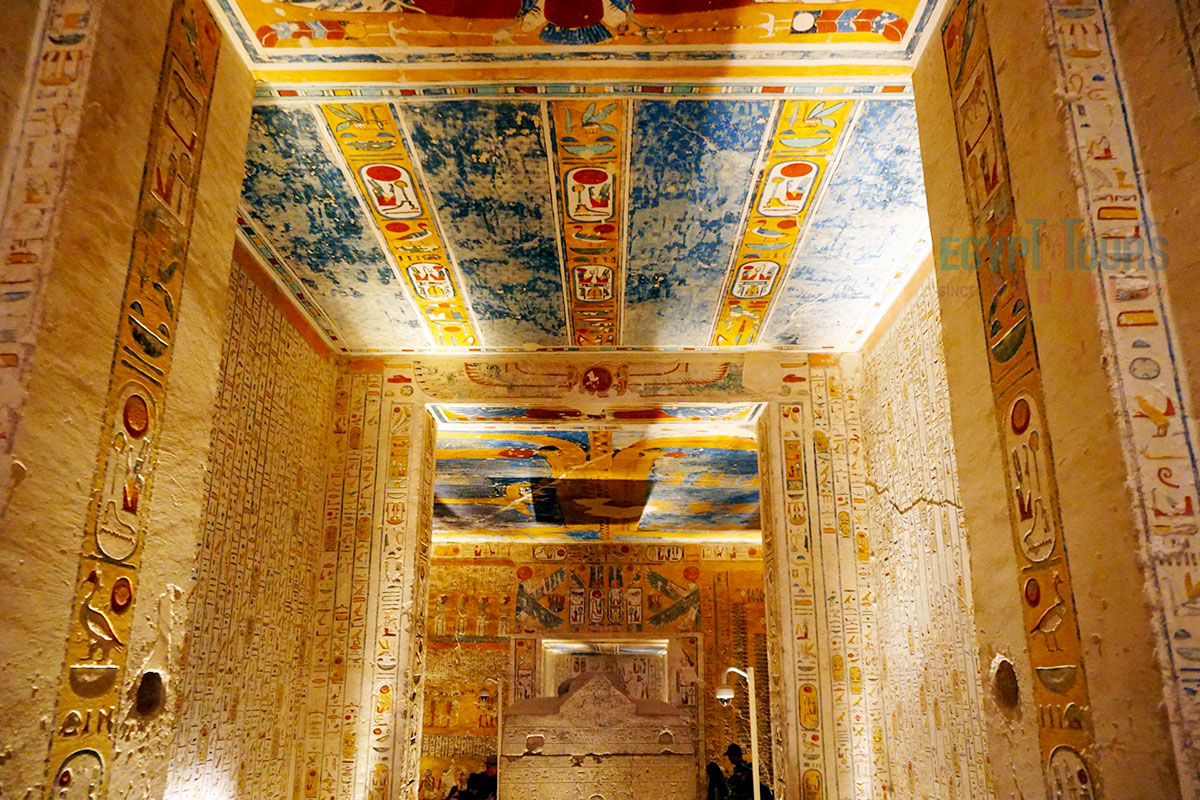
The artistic achievements of the New Kingdom were unparalleled in both scale and refinement, even during its time. Ancient Egyptian art during this time became more realistic and expressive, particularly during the reign of Akhenaten, “ Amarna Period Art”, which introduced a style that broke away from the rigid, formal depictions of the past. Art began to capture more naturalistic and intimate scenes, especially in the representation of the royal family, where Akhenaten, Nefertiti, and their children were shown in tender and informal poses.
Across the New Kingdom, art is renowned for its colossal statues, elaborate tomb paintings, and the intricate decoration of royal tombs in the Valley of the Kings. These ancient Egyptian tombs were adorned with vivid scenes depicting the journey of the soul to the afterlife, as described in the Book of the Dead. One of the finest examples of New Kingdom art is the Valley of the Kings, which houses some of the most captivating paintings, and Abu Simbel Temples of Ramses II, whose gigantic seated statues were designed to demonstrate the pharaoh’s power and divine authority.

The New Kingdom was marked by major religious developments and a critical shift. At the core of traditional Egyptian religion during this time was Amun-Ra, who was a composite deity formed by merging the sun god Ra with the god Amun. Amun-Ra became the most prominent deity out of all the ancient Egyptian gods in Egyptian theology, and his cult was centered at the temple complex of Karnak in the then-religious capital, Thebes.
The reign of Akhenaten (1353–1336 BCE) brought about a radical shift as he established a new religion centered on the worship of the Aten, “the sun disk,” introducing a form of monotheism, which is the worship of one god. He ordered the closure of traditional temples and moved the capital to Akhetaten (modern-day Amarna). This shift deeply disrupted Egypt’s traditional religious institutions. After Akhenaten’s death, his successors, most notably Tutankhamun, restored the old religious practices and returned the capital to Thebes.
Discover the great religion of the ancient Egyptian civilization
Read More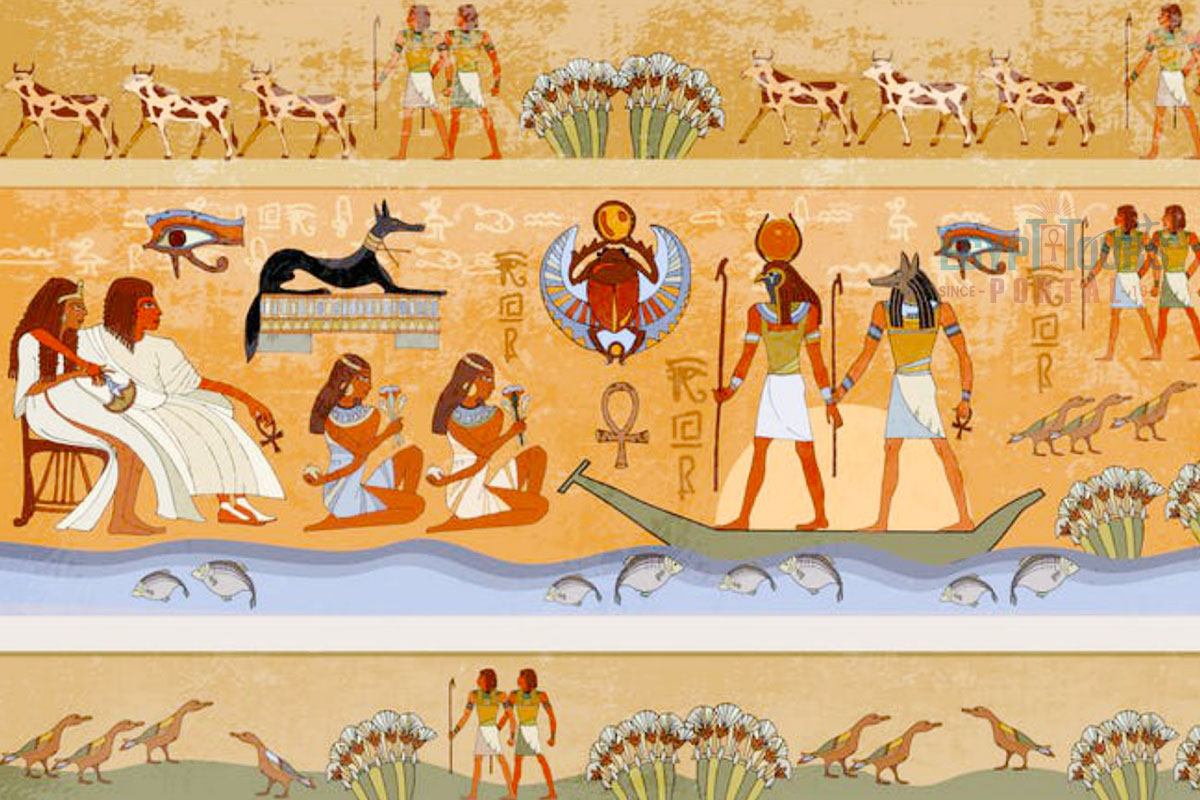
The ancient Egyptian economy of the New Kingdom was thriving, fueled by agriculture, trade, and the spoils of war. Egypt’s agricultural prosperity was largely based on the Nile River, which provided fertile land for growing grain, flax, and papyrus. Conquests in Nubia and the Levant brought vast amounts of gold, slaves, and exotic goods into Egypt, enriching the state. Trade was an essential part of the economy.
Egypt established important trading routes with neighboring regions such as Punt, Byblos, and the Aegean. The kingdom imported luxury items like incense, ivory, and ebony while exporting goods such as grain, linen, and gold. Egypt’s wealth was further increased by the state’s control over mining operations, especially the gold mines in Nubia and the copper mines in Sinai.

The New Kingdom is best known for its awe-inspiring architectural feats, with pharaohs embarking on massive construction projects to honor the gods and glorify their reigns. Some of the most famous architectural achievements include:
The Karnak Temple Complex: Dedicated to Amun-Ra, it is the largest religious building ever constructed, featuring colossal statues, obelisks, and massive columns.
The Luxor Temple: Built by Amenhotep III and expanded by Ramses II, this temple was a focal point for religious festivals.
The Valley of the Kings: A royal burial ground, it houses the tombs of famous pharaohs such as Tutankhamun, Seti I, and Ramses II.
Abu Simbel: Ramses II’s grand temple, carved into a mountainside, features four colossal statues of the pharaoh, designed to impress and intimidate Egypt’s southern neighbors.
Explore the extraordinary architecture of the ancient Egyptian civilization
Read More

Ancient Egyptian Clothing in the New Kingdom reflected social status, with wealthier Egyptians wearing more intricately designed garments made of fine linen. Both men and women donned pleated skirts and sheer robes, sometimes adorned with colorful sashes or belts, plus wigs. Jewelry, including necklaces, bracelets, and earrings made of gold, turquoise, and lapis lazuli, was widely worn by the elite.
Wigs were an important aspect of Egyptian fashion, often made from human hair or wool, and were worn by both sexes. Eye makeup, particularly kohl, was applied to enhance beauty but also to protect against the sun’s glare.
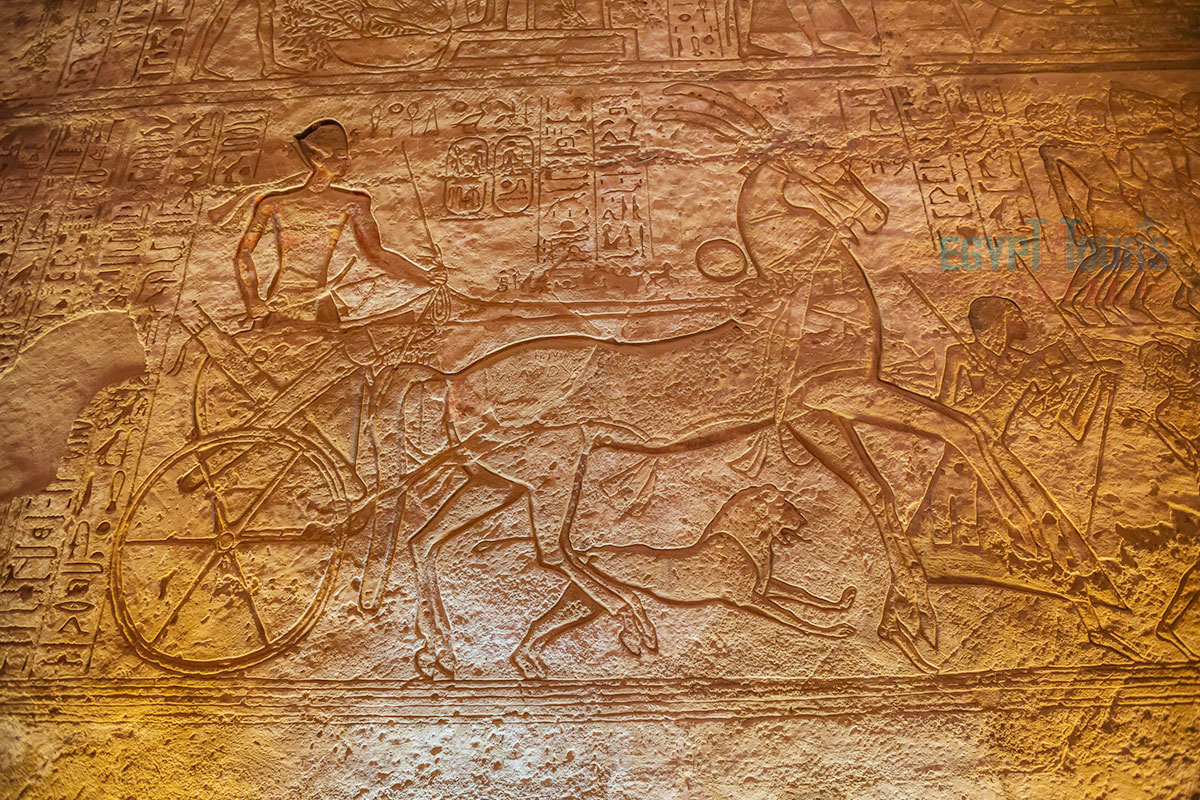

The New Kingdom was a time of significant technological and intellectual innovation, which enhanced Egypt's military, economic, and cultural standing. Key inventions and advancements from this period include:
Chariots were heavily refined during the New Kingdom, transforming Egypt’s army into a highly effective military force. These two-wheeled chariots, drawn by horses, became crucial for fast-moving attacks, giving the Egyptians an advantage over enemies in open combat, especially in battles like Megiddo and Kadesh.
Glass-Making became a pioneer in glass production, developing advanced techniques to create fine glassware, including vessels, beads, and amulets. These glass objects were highly prized and often traded as luxury items with neighboring regions. Architectural Innovations during the New Kingdom allowed for the construction of more durable and monumental buildings. Temples, tombs, and statues were built on a grander scale than ever before, featuring intricate carvings, massive stone blocks, and obelisks.
Structures like the Abu Simbel temples and Karnak stand as testaments to these advancements. The use of papyrus for writing and record-keeping became widespread, helping to document religious texts, royal decrees, and administrative matters. This innovation also supported the spread of literature, enhancing communication across the empire and preserving important knowledge.
Medical practices, especially in mummification and embalming, were further perfected during the New Kingdom, as ancient Egyptians refined their understanding of anatomy and preservation techniques to ensure a proper journey to the afterlife.
Explore the incredible inventions of the ancient Egyptian civilization
Read More
The ancient Egyptian literature of the New Kingdom flourished, with a strong emphasis on religious texts, poetry, and historical accounts that reflected the beliefs, values, and achievements of Egyptian society. Key literary works from this era include:
The Book of the Dead is perhaps one of the most famous ancient Egyptian texts from the New Kingdom. It consists of a collection of spells, prayers, and incantations designed to help the deceased navigate the afterlife and achieve eternal life. These texts were often inscribed on tomb walls or written on papyrus and placed in tombs.
Poetry and Hymns during this period were dedicated to gods and pharaohs. Hymns to gods like Amun-Ra were common, as well as love poetry that celebrated beauty and romance. Historical Accounts of Pharaohs like Ramses II often commemorated their military victories and achievements through inscriptions on temple walls. These texts provided a historical record of important events, such as the Battle of Kadesh, and served to glorify the pharaoh’s reign.
Moral and philosophical writings, known as wisdom literature, were also popular. These texts offered guidance on ethics, proper behavior, and the responsibilities of individuals in society, particularly for scribes and administrators. New Kingdom literature was not only religious but also deeply didactic, offering lessons in governance, loyalty, and the relationship between humanity and the divine.
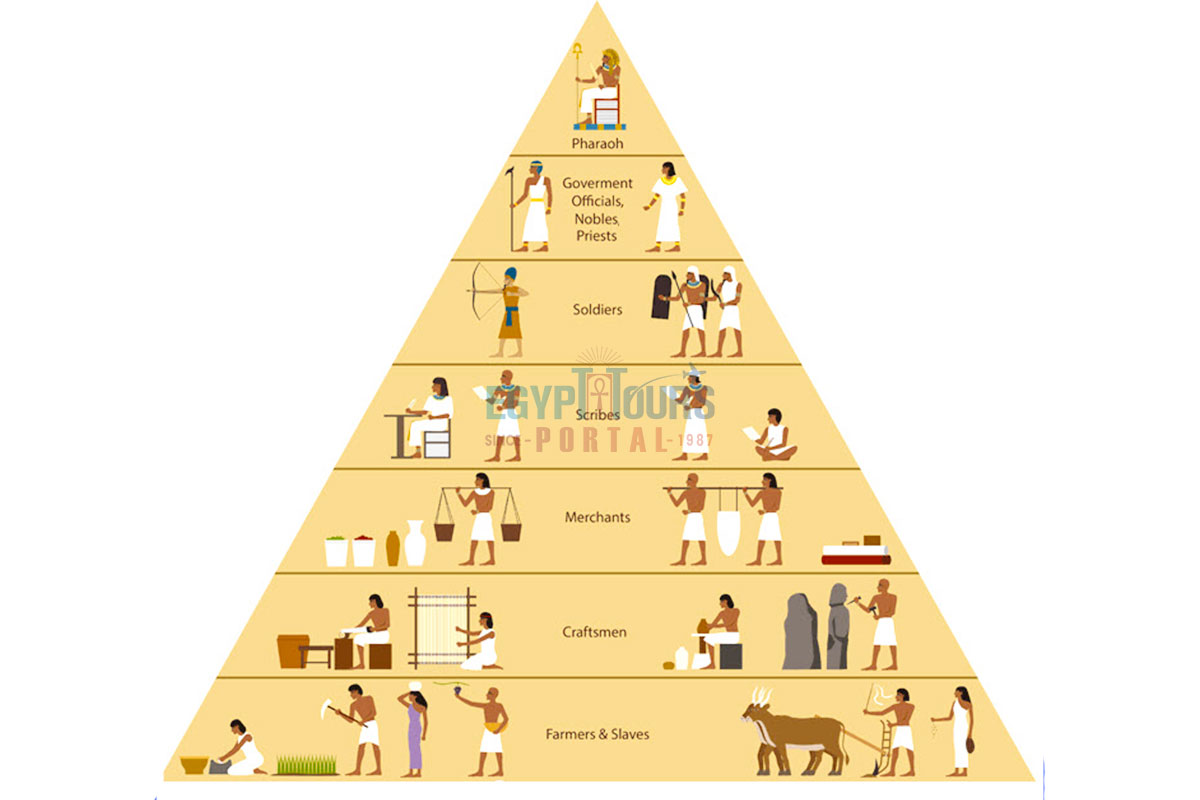
The ancient Egyptian social structure during the New Kingdom was highly hierarchical, with a clear distinction between the different classes. The structure can be summarized as follows:
The Pharaoh at the top of the social hierarchy was the pharaoh, considered a divine ruler and the representative of the gods on earth. The pharaoh had absolute control over the state and military, and his authority was reinforced through religion, monumental architecture, and ceremonial practices. Beneath the pharaoh were the nobility and the priesthood.
Nobles held important positions in the royal court, overseeing administration, military affairs, and provincial governance. The ancient Egyptian priests, particularly those serving in the temples of Amun, held significant religious and political power, particularly in cities like Thebes. The priesthood of Amun became so powerful that it sometimes rivaled the authority of the pharaoh.
Scribes played a crucial role in New Kingdom society, as they were responsible for record-keeping, tax collection, and the administration of state affairs. They were well-educated and held in high regard, often rising to prominent administrative positions. Skilled workers, including craftsmen, architects, and artists, enjoyed a higher status than laborers. They were responsible for the construction of temples, tombs, and the production of luxury goods like jewelry and statues.
Many of these artisans lived in special communities, such as Deir el-Medina, where they worked on royal tombs in the Valley of the Kings. The vast majority of the population were farmers and laborers, who worked the land or were employed in state construction projects. Although they had little social mobility, their work was vital to the economy, especially in terms of agriculture, which was the backbone of Egypt's wealth.
At the bottom of the social pyramid were prisoners of war or those who fell into debt. They were employed in a variety of tasks, from labor in fields to work in royal households, though their treatment could vary widely. While the social system was rigid, there were opportunities for social mobility, especially for scribes and military officers who could rise through the ranks if they demonstrated talent and loyalty to the state.

Wealth in the New Kingdom was concentrated among the elite, primarily the pharaoh, the nobles, and the priests. These groups controlled large estates, including agricultural land, livestock, and labor. Temples amassed significant wealth, and military commanders were often rewarded with land for their service. Commoners had fewer opportunities to own property, though women in ancient Egypt could own and inherit land, offering them some level of economic power.
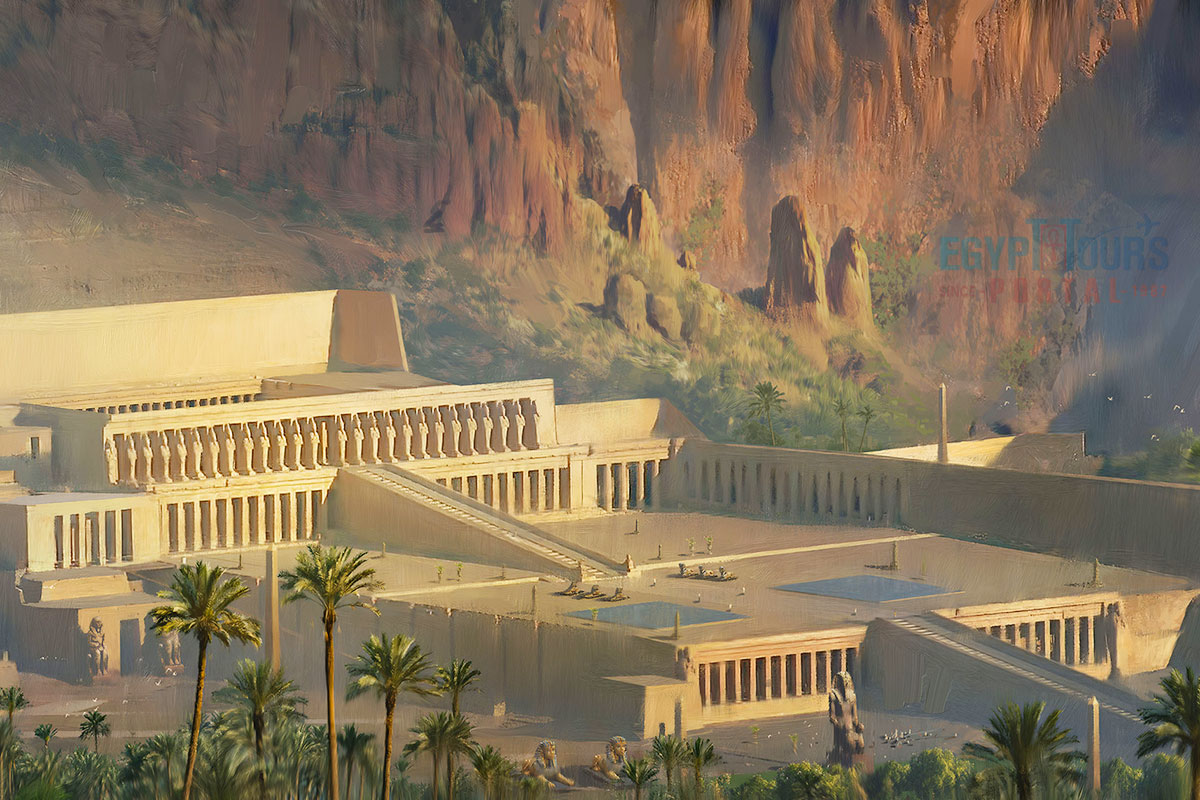
The capital of Egypt during the New Kingdom was Thebes (modern-day Luxor), a major religious and cultural center. Thebes was home to the Karnak Temple Complex and the Valley of the Kings, making it both the spiritual heart and the burial place for the pharaohs of this era. During the reign of Akhenaten, the capital briefly shifted to Akhetaten (modern Amarna), but it returned to Thebes after his death.

The New Kingdom’s power and wealth came from several key factors:
Military Conquests: Successful campaigns in Nubia and the Levant brought in vast riches and resources, including gold, a massive population, and tribute.
Trade Networks: Egypt’s trading connections extended to Punt, Byblos, and the Aegean, enriching the kingdom with luxury goods and strengthening its economy.
Agriculture: The fertile Nile Valley allowed for bountiful harvests, providing a stable food supply and surplus for trade.
Monumental Architecture: Pharaohs invested heavily in monumental construction projects, reinforcing their divine status and consolidating political power.
The true glory of the new kingdom of Egypt started in the 18th century at the hands of Ahmose I ( 1550-1525 BC ), who sought to avenge his family and liberate his country from the Hyksos and unite his country into one complete empire under the Theban rule.
He worked on restoring all of Egypt's territories of Canaan and Nubia, creating a buffer zone to prevent any future invasions and putting the unified country of Egypt on a course to becoming a powerful empire by reorganizing the administration of management, establishing mines and trade routes, and constructing massive architectural projects.
His successor Amunhotep I (1526–1506 BC ) continued his legacy by making Egypt part of the ancient club of great powers with Babylon, the Hittites, and Mitanni which Egypt had trade and diplomatic relations. He was followed by Thutmose I (1506–1493 BC), when Egyptian power and wealth reached their climax.
Then came Queen Hatshepsut (1479 – 1458 BC), one of the most successful pharaohs in ancient Egyptian history, as she was the longest-reigning female pharaoh in Egypt for 20 years, and for sent an expedition to the land of Punt, which became a trade partner.
After she came to the Napoleon of Ancient Egypt, Thutmose III (1479–1425 BC), expanded the Egyptian Empire to the highest levels of power and wealth and achieved great success, which made it easy for all the future generations of pharaohs to drive this empire into true greatness.
His army is also highly skilled and powerful, as it shows in the battle of Megiddo. Afterwards came Ramses II “The Great” (1279–1213 BC) who was one of Egypt’s most iconic pharaohs, known for his military leadership at the Battle of Kadesh, which led to the first recorded peace treaty. He left behind monumental architectural achievements like Abu Simbel and the Ramesseum, expanded major temples, and was worshipped as a living god during his reign.
Soon, later on, came the end of the tale, where moments of greatness started to fade away like the defeat of the battle of Peluism, which same the fall of the dynastic era of Egypt and the rise of the Greco-Roman period.
The New Kingdom of Ancient Egypt was a period of extraordinary achievements in military, cultural, and political spheres. With iconic rulers, groundbreaking religious reforms, and unparalleled architectural feats, this era left a lasting legacy that continues to fascinate and inspire the modern world, which everyone can explore with ease with our incredible Egypt tours and Nile cruises.
Private 4 Days Cairo Tour Packages for British Travelers 4 days Cairo Egypt Tour pac...
Tour Location: Cairo – Giza...
5 Days Cairo and Alexandria Tour Package For British Travelers 5 days Cairo and Alex...
Tour Location: Cairo/Giza/Alexandria...
6 Days Cairo, Luxor & Aswan Tour Package For British Travelers 6 days Cairo, Lux...
Tour Location: Cairo/Giza/Aswan/Luxor...
Amazing 7 Days Cairo and Hurghada Holiday for British Travelers 7 Days Cairo & H...
Tour Location: Cairo – Giza – Hurgh...
The New Kingdom is renowned as the most prosperous and powerful period in Egyptian history, marked by several key developments:
Military Expansion: Egypt became a dominant empire through conquests in Nubia, Canaan, and the Near East, led by pharaohs like Thutmose III and Ramses II.
Monumental Architecture: Grand temples like Karnak, Luxor, and Abu Simbel, as well as the royal tombs in the Valley of the Kings, were built.
Religious Shifts: The radical shift to monotheism under Akhenaten, who promoted worship of Aten, the sun god, briefly disrupted traditional polytheism, which was later restored.
Art and Culture: Artistic achievements flourished, emphasizing more realistic depictions in sculptures, paintings, and funerary art.
Famous Pharaohs: Iconic rulers like Tutankhamun, Hatshepsut, and Ramses II left legacies that continue to shape modern perceptions of ancient Egypt.
The New Kingdom lasted for approximately 500 years, from 1570 BCE to 1070 BCE. It included three dynasties: the 18th, 19th, and 20th.
The New Kingdom existed from 1570 BCE to 1070 BCE. It began with Ahmose I, who expelled the Hyksos and reunified Egypt, and ended with the start of the Third Intermediate Period, characterized by a weakening of central authority and foreign invasions.
The fall of the New Kingdom resulted from a mix of internal and external pressures:
Weakening Central Authority: The growing influence of the priests of Amun, particularly in Thebes, eroded the power of the pharaohs, creating division.
Economic Decline: Prolonged military campaigns and fewer conquests reduced the state’s wealth.
Foreign Invasions: Egypt faced attacks from the Sea Peoples, Libyans, and later the Assyrians.
Internal Strife: Conflicts between religious and political factions weakened the state, eventually leading to the Third Intermediate Period and subsequent foreign domination, including by the Persians.
The New Kingdom saw the rule of several notable pharaohs:
Ahmose I (1570–1546 BCE), founder of the 18th Dynasty, who reunified Egypt after expelling the Hyksos.
Hatshepsut (1479–1458 BCE), one of the few female pharaohs, was known for her prosperous reign and architectural projects.
Thutmose III (1479–1425 BCE) expanded Egypt’s empire through military conquests.
Akhenaten (1353–1336 BCE) introduced the worship of Aten, a form of monotheism.
Tutankhamun (1333–1324 BCE), famous for his nearly intact tomb.
Ramses II (1279–1213 BCE), a powerful ruler known for his military successes and the construction of the Abu Simbel temples.
Several major changes characterized the New Kingdom:
Territorial Expansion: Egypt expanded its empire into Nubia, Canaan, and the Near East, increasing its wealth and political influence.
Religious Transformation: Akhenaten's introduction of monotheism (focused on Aten) marked a radical break from Egypt’s traditional polytheism, although the change was reversed after his reign.
Artistic Development: Art became more realistic and expressive, especially during the Amarna Period under Akhenaten, depicting more intimate scenes of the royal family.
Architectural Innovations: Monumental temples, tombs, and statues were constructed, such as Karnak, Luxor, and the Valley of the Kings.
International Relations: Egypt strengthened diplomatic ties with other great powers, including Babylon, the Hittites, and Mitanni, leading to alliances and peace treaties, like the Treaty of Kadesh signed by Ramses II after the Battle of Kadesh.
The entire country of Egypt deserve to be explored with its every heavenly detail but there are places that must be seen before any other such as the breathtaking Hurghada's red sea, The wonders of Cairo the pyramids of Giza, the great sphinx, the Egyptian Museum, Khan El Khalili Bazaar, the wonders of Luxor like Valley of the Kings, Karnak & Hatshepsut temple and the wonders of Aswan such as Abu Simbel temples, Philea temple, Unfinished obelisk and The Wonders of Alexandria like Qaitbat Citadel, Pompey's Pillar and Alexandria Library. Read more about the best places to visit in Egypt.
If you want to apply for a Visa On Arrival that lasts for 30 days then you should be one of the eligible countries, have a valid passport with at least 6 months remaining and pay 25$ USD in cash, as for the E-Visa for 30 day you should have a valid passport for at least 8 months, complete the online application, pay the e-visa fee then print the e-visa to later be presented to the airport border guard. You could also be one of the lucky ones who can obtain a free visa for 90 days. Read more about Egypt travel visa.
Egypt has a variety of delicious cuisines but we recommend “Ful & Ta’meya (Fava Beans and Falafel)”, Mulukhiya, “Koshary”, a traditional Egyptian pasta dish, and Kebab & Kofta, the Egyptian traditional meat dish.
The best time to travel to Egypt is during the winter from September to April as the climate becomes a little tropical accompanied by a magical atmosphere of warm weather with a winter breeze. You will be notified in the week of your trip if the Climate is unsafe and if any changes have been made.
You should pack everything you could ever need in a small bag so you could move easily between your destinations.
We have been creating the finest vacations for more than 20 years around the most majestic destinations in Egypt. Our staff consists of the best operators, guides and drivers who dedicate all of their time & effort to make you have the perfect vacation. All of our tours are customized by Travel, Financial & Time consultants to fit your every possible need during your vacation. It doesn't go without saying that your safety and comfort are our main priority and all of our resources will be directed to provide the finest atmosphere until you return home.
You will feel safe in Egypt as the current atmosphere of the country is quite peaceful after the government took powerful measures like restructuring the entire tourist police to include all the important and tourist attractions in Egypt. Read more about is it safe to travel to Egypt.
Wear whatever feels right and comfortable. It is advised to wear something light and comfortable footwear like a closed-toe shoe to sustain the terrain of Egypt. Put on sun block during your time in Egypt in the summer to protect yourself from the sun.
The best activity is by far boarding a Nile Cruise between Luxor and Aswan or Vise Versa. Witness the beauty of Egypt from a hot balloon or a plane and try all the delicious Egyptian cuisines and drinks plus shopping in old Cairo. Explore the allure and wonders of the red sea in the magical city resorts of Egypt like Hurghada and many more by diving and snorkeling in the marine life or Hurghada. Behold the mesmerizing western desert by a safari trip under the heavenly Egyptian skies.
There are a lot of public holidays in Egypt too many to count either religious or nation, the most important festivals are the holy month of Ramadan which ends with Eid Al Fitr, Christmas and new years eve. Read more about festivals & publich holidays in Egypt.
Egypt is considered to be one of the most liberal Islamic countries but it has become a little bit conservative in the last couple of decades so it is advised to avoid showing your chest, shoulders or legs below the knees.
Arabic is the official language and Most Egyptians, who live in the cities, speak or understand English or at least some English words or phrases. Fewer Egyptians can speak French, Italian, Spanish, and German. Professional tour guides, who work in the tourism sector, are equipped to handle visitors who cannot speak Arabic and they will speak enough English and other languages to fulfill the needs of all our clients.
The fastest way is a car, of course, a taxi. If you are in Cairo ride a white taxi to move faster or you could board the fastest way of transportation in Egypt metro if the roads are in rush hour.
The temperature in Egypt ranges from 37c to 14 c. Summer in Egypt is somehow hot but sometimes it becomes cold at night and winter is cool and mild. The average of low temperatures vary from 9.5 °C in the wintertime to 23 °C in the summertime and the average high temperatures vary from 17 °C in the wintertime to 32 °C in the summertime. The temperature is moderate all along the coasts.
It is the home of everything a traveler might be looking for from amazing historical sites dating to more than 4000 years to enchanting city resorts & beaches. You will live the vacation you deserve as Egypt has everything you could possibly imagine.









